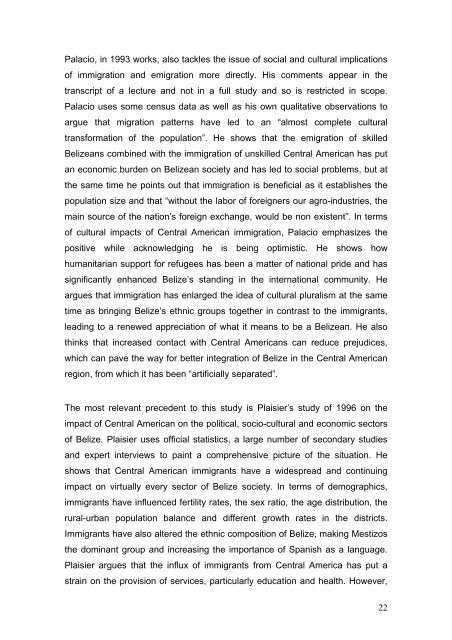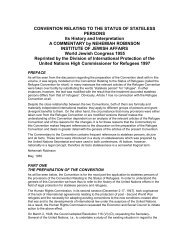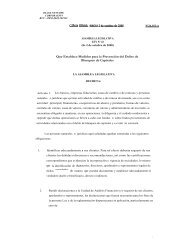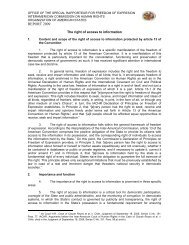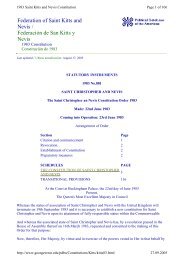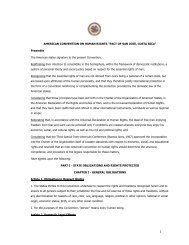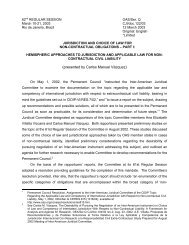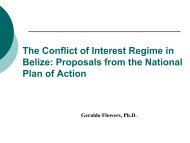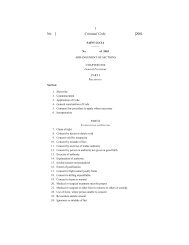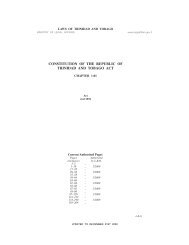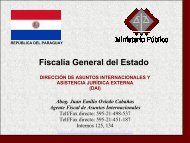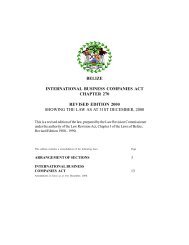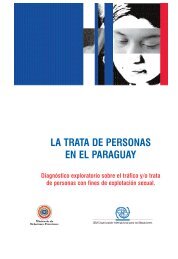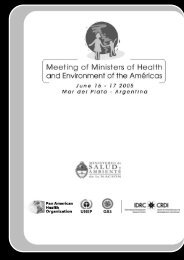TRAFFICKING OF PERSONS IN BELIZE - OAS
TRAFFICKING OF PERSONS IN BELIZE - OAS
TRAFFICKING OF PERSONS IN BELIZE - OAS
You also want an ePaper? Increase the reach of your titles
YUMPU automatically turns print PDFs into web optimized ePapers that Google loves.
Palacio, in 1993 works, also tackles the issue of social and cultural implications<br />
of immigration and emigration more directly. His comments appear in the<br />
transcript of a lecture and not in a full study and so is restricted in scope.<br />
Palacio uses some census data as well as his own qualitative observations to<br />
argue that migration patterns have led to an “almost complete cultural<br />
transformation of the population”. He shows that the emigration of skilled<br />
Belizeans combined with the immigration of unskilled Central American has put<br />
an economic burden on Belizean society and has led to social problems, but at<br />
the same time he points out that immigration is beneficial as it establishes the<br />
population size and that “without the labor of foreigners our agro-industries, the<br />
main source of the nation’s foreign exchange, would be non existent”. In terms<br />
of cultural impacts of Central American immigration, Palacio emphasizes the<br />
positive while acknowledging he is being optimistic. He shows how<br />
humanitarian support for refugees has been a matter of national pride and has<br />
significantly enhanced Belize’s standing in the international community. He<br />
argues that immigration has enlarged the idea of cultural pluralism at the same<br />
time as bringing Belize’s ethnic groups together in contrast to the immigrants,<br />
leading to a renewed appreciation of what it means to be a Belizean. He also<br />
thinks that increased contact with Central Americans can reduce prejudices,<br />
which can pave the way for better integration of Belize in the Central American<br />
region, from which it has been “artificially separated”.<br />
The most relevant precedent to this study is Plaisier’s study of 1996 on the<br />
impact of Central American on the political, socio-cultural and economic sectors<br />
of Belize. Plaisier uses official statistics, a large number of secondary studies<br />
and expert interviews to paint a comprehensive picture of the situation. He<br />
shows that Central American immigrants have a widespread and continuing<br />
impact on virtually every sector of Belize society. In terms of demographics,<br />
immigrants have influenced fertility rates, the sex ratio, the age distribution, the<br />
rural-urban population balance and different growth rates in the districts.<br />
Immigrants have also altered the ethnic composition of Belize, making Mestizos<br />
the dominant group and increasing the importance of Spanish as a language.<br />
Plaisier argues that the influx of immigrants from Central America has put a<br />
strain on the provision of services, particularly education and health. However,<br />
22


